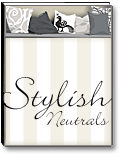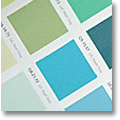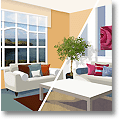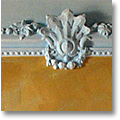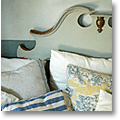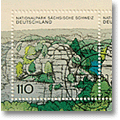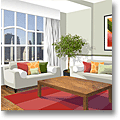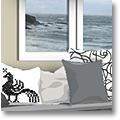Monochromatic Color Scheme:
Tips & Tricks
A monochromatic color scheme consists of a single color that is either left pure, or mixed with
- white,
- gray, or
- black.
On this page, we'll take a monochromatic room through a series of color experiments.
Monochromatic Color Scheme:
The Fine Print
You'd be forgiven to think that 'single color' means something like, "just blue (but not purple or turquoise)".
But that's not the case. According to the monochromatic color police, true monochrome schemes must be based on a single (="mono") hue (="chroma") - meaning just one blue out of hundreds of thousands (!) of possible blue hues.
And it doesn't end there.
In a strictly monochromatic room color scheme, no 'real' color is allowed for mixing. The only way to vary a monochromatic room color scheme is to mix the color with "non-colors" (white, black, or black-plus-white [=gray]).
So let's do a series of experiments and see what a monochromatic color scheme can look like in a room.
Towards the end, we'll start cheating ;-)
One Room, One Color
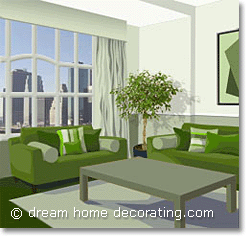
Here's a monochromatic room completely decked out in variations of one green hue:

(Yep, that's the one!)
To make the room livable, the technicolor saturation has been toned down with white, gray, and/or black (except for the potted tree in the corner, which is as it came from the shop).
And it's not just because of the little tree that this is not an entirely monochromatic
color scheme. The view from the window isn't green. (That's something every
monochrome-decorating purist will have to contend with: A bit of blue sky, and your ambitions
are ruined.)
Monochromatic Colors Plus Non-Colors
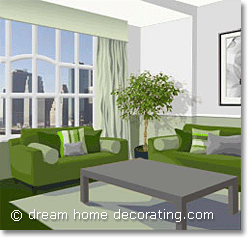
Some theorists will allow strictly neutral whites, grays and blacks to appear as part of a monochromatic color scheme, because these neutrals don't add any color of their own.
So I've tried that here.
There's a monochromatic picture in grayscale on the wall.
Also, the color of the coffee table, two sofa cushions, the window frame, and the wall color above the chair rail have all changed into completely neutral shades of gray.
What do you think?
While this may count as a perfectly monochromatic room, I personally don't think the color scheme really works.
And that's because a neutral gray - without any color admixtures to turn it 'cool' or 'warm' - just
looks dead when you see it next to 'real' color.
A Monochromatic Color Scheme
'Soaked' in Warm Neutrals
So let's hope the monochromatic color authorities aren't looking while we add some color-infused neutrals to the room. This is a subtle change, but it makes all the difference.
For starters, let's replace the carpet with wooden flooring, and let's change the coffee table
to a grainy dark wood that echoes the floorboards.
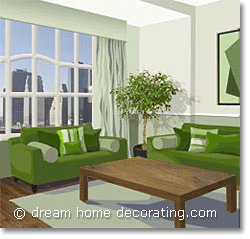
To repeat the warm brown tones elsewhere in the room, we'll give the green wall above the chair rail a manila-envelope brown tinge; just a blush of warmth against the base color.
Can you see how that changes the look and feel?
The room is still in monochromatic colors (sort of), but it looks much more 'grounded' than before.
At the same time, the color scheme is still a bit too 'samey' for my taste.
I think it needs a few accents in a cooler color. So let's try a ...
... Monochromatic Color Scheme With
Analogous-Color Accents
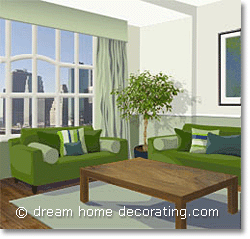
This time, we'll trespass into neighboring color territory.
"Analogous" means 'bearing some resemblance or proportion', in other words, being similar to something else.
An analogous color scheme is composed of hues that are adjacent to each other on the color wheel.
So I've gone to the 'blue side' of green for a slightly turquoisey, darkish blue-green.
I've only changed two of the sofa cushions and part of the picture on the wall into this color, but see
what a difference it makes - it brings the green to life.
Monochromatic Color Scheme: Recap
Here's our monochromatic room again, in its four incarnations:
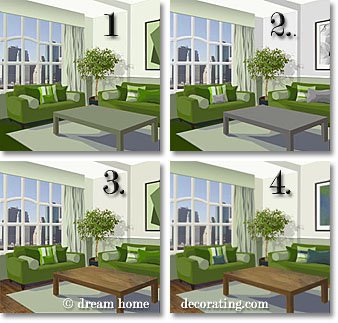
- Which version did you like best? Why?
- If you were to decorate a room in a monochromatic color scheme, which color would you choose?
- Would you add neutrals?
- Would you add an analogous color? Which one?
- Do you have a monochromatic room? (Send me a picture ;-)
- Neutral Color Schemes - The
Book:
Learn about using neutral color palettes in your home. Understand what makes neutral color schemes look their best, and what happens when you inject 'real' color into neutral color palettes. It's FREE!! - Understand the color wheel chart!
- How do primary colors hang together?
- Black in the bathroom? - color psychology will tell you why - or why not - that's a good idea.
- Click on the individual colors to read up on their psychological effects: white, gray, black, brown, yellow, orange, red, pink, purple, blue, green.
- Go beyond a monochromatic color scheme - create a home with a French accent!
- Tuscany is where everyone wants a house - at least for the summer holidays. Take these examples of Tuscan colors and create a Tuscan look, wherever you are.
- For your sweetest dreams ... check out some illustrated bedroom color schemes.
- You could even 'color code' your home with color meanings (it's good fun!)

